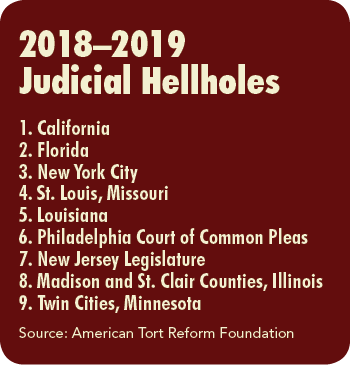California has landed atop the “Judicial Hellholes” list again, according to the latest ranking of the “most unfair” civil litigation courts by the American Tort Reform Foundation (ATRF).
Trailing not far behind California are Florida, New York City and St. Louis, Missouri. California was last at No. 1 in 2015–2016, and also held the No. 1 title in 2013–2014 and 2012–2013.
 A recent study by the U.S. Chamber Institute for Legal Reform highlights both the overall cost and inefficiencies of the tort system. The report states that the cost and compensation paid in the U.S. tort system totaled $429 billion in 2016, accounting for 2.3% of the U.S. gross domestic product. The data clearly demonstrate the need for a more balanced civil justice system, the report states.
A recent study by the U.S. Chamber Institute for Legal Reform highlights both the overall cost and inefficiencies of the tort system. The report states that the cost and compensation paid in the U.S. tort system totaled $429 billion in 2016, accounting for 2.3% of the U.S. gross domestic product. The data clearly demonstrate the need for a more balanced civil justice system, the report states.
According to the report, California is a perennial Judicial Hellhole because “California judges and legislators alike have a propensity to expand liability at almost every given opportunity.”
Innovator Liability
At the end of 2017, the California Supreme Court became just the second state high court to adopt the theory of “innovator liability.” This theory exposes a company that invested millions or billions of dollars into developing a medication to liability when a person who took a generic version made by a competitor alleges an injury from the drug.
California’s decision to adopt innovator liability makes it an outlier, according to the report. At least 35 state and federal courts have rejected innovator liability, which is a disincentive for companies to develop medications that save and improve lives.
Frivolous Prop. 65 Litigation
Baseless Proposition 65 litigation unjustly burdens companies that do business in California. The originally well-intentioned law, enacted in 1986, is now one of the plaintiffs’ bar’s favorite tools to exploit.
A troublesome part of the law allows private citizens, advocacy groups and attorneys to sue on behalf of the state and collect a portion of the civil fees, creating an incentive for the plaintiffs’ bar to create these types of lawsuits.
Each year, attorneys send thousands of notices to companies threatening Prop. 65 litigation and demanding a settlement. A search of notices on the California Attorney General’s website shows that the number of these threatened lawsuits has tripled over the last decade. Food and beverage companies are among the prime targets.
Private Attorneys General Act
Enacted in 2004, California’s Private Attorneys General Act (PAGA) has become a means around arbitration clauses in employment contracts that limit costly, plaintiffs’ lawyer-enriching class actions. PAGA authorizes “aggrieved” employees to file lawsuits seeking civil penalties on behalf of themselves, other employees and the State of California for Labor Code violations. Many PAGA lawsuits revolve around technical nitpicks, such as an employer’s failure to print its address on employees’ pay stubs, even though the address was printed on the paychecks themselves.
Seventy-five percent of penalties paid by noncompliant employers go to the state Labor and Workforce Development Agency; only 25% goes to the “aggrieved employees” and their lawyers, who take a third or so of that. In some cases, the plaintiffs’ lawyers receive even more. For example, plaintiffs’ lawyers walked away with 40% of a recent $9 million PAGA settlement with Target.
Food Court
California courts, both state and federal, continue to be ground-zero for “no-injury” consumer protection lawsuits targeting the food and beverage industry.
The number of lawsuits has risen sharply in recent years. Since 2012, plaintiffs’ lawyers have filed more than 500 class actions challenging the marketing or labeling of food nationwide. About one-third of the food class action litigation in federal courts nationwide is in the Northern District of California, also known as the “Food Court,” located in San Francisco.
California is a favorite for these lawsuits due to its plaintiff-friendly Unfair Competition Law (UCL) and the potential to bring large class actions. Many of the targeted companies settle the litigation instead of risking the high cost of a trial and the negative publicity that would follow, leading to multimillion-dollar settlements that feed the plaintiffs’ bar and provide little to no benefit for consumers.
Targeting Small Businesses
A large number of lawsuits were filed under the Americans with Disabilities Act (ADA) in federal court against California businesses in 2017—2,751 lawsuits—up from 2,468 in 2016. California had the most ADA accessibility lawsuits of any state and almost double the amount of the next closest state, Florida (1,488).
In California, penalties for ADA violations are much higher than other states due to the Unruh Civil Rights Act, which allows plaintiffs to recover compensatory damages of $4,000 per violation (compared to $1,000 under federal law) plus attorneys’ fees. Often these “violations” are as minor as a mirror that is an inch too high or a sidewalk or parking lot that is angled one degree too much.
Not only are plaintiffs’ attorneys targeting “brick and mortar” stores, they are now targeting companies for website accessibility issues. Through the first six months of 2018, 2,155 lawsuits alleging that online shopping and other websites did not sufficiently accommodate individuals with visual impairments were filed in California. That number is more than double the next highest state, New York (1,026).
The full report is available at www.judicialhellholes.org.


